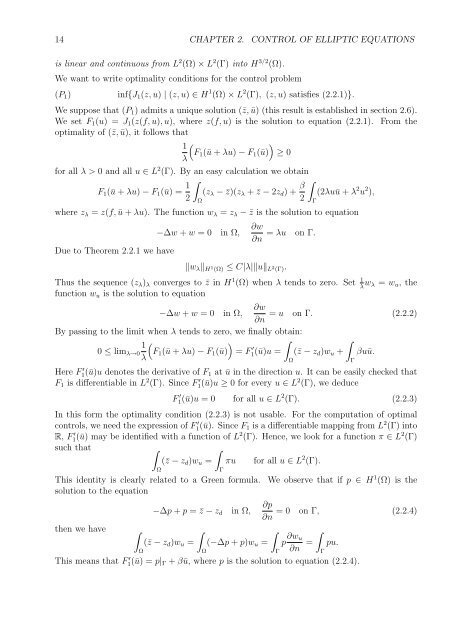Optimal Control of Partial Differential Equations
Optimal Control of Partial Differential Equations
Optimal Control of Partial Differential Equations
You also want an ePaper? Increase the reach of your titles
YUMPU automatically turns print PDFs into web optimized ePapers that Google loves.
14 CHAPTER 2. CONTROL OF ELLIPTIC EQUATIONS<br />
is linear and continuous from L 2 (Ω) × L 2 (Γ) into H 3/2 (Ω).<br />
We want to write optimality conditions for the control problem<br />
(P1) inf{J1(z, u) | (z, u) ∈ H 1 (Ω) × L 2 (Γ), (z, u) satisfies (2.2.1)}.<br />
We suppose that (P1) admits a unique solution (¯z, ū) (this result is established in section 2.6).<br />
We set F1(u) = J1(z(f, u), u), where z(f, u) is the solution to equation (2.2.1). From the<br />
optimality <strong>of</strong> (¯z, ū), it follows that<br />
1<br />
<br />
<br />
F1(ū + λu) − F1(ū) ≥ 0<br />
λ<br />
for all λ > 0 and all u ∈ L2 (Γ). By an easy calculation we obtain<br />
F1(ū + λu) − F1(ū) = 1<br />
2<br />
<br />
(zλ − ¯z)(zλ + ¯z − 2zd) +<br />
Ω<br />
β<br />
2<br />
<br />
(2λuū + λ<br />
Γ<br />
2 u 2 ),<br />
where zλ = z(f, ū + λu). The function wλ = zλ − ¯z is the solution to equation<br />
Due to Theorem 2.2.1 we have<br />
−∆w + w = 0 in Ω,<br />
∂w<br />
∂n<br />
wλ H 1 (Ω) ≤ C|λ|u L 2 (Γ).<br />
= λu on Γ.<br />
Thus the sequence (zλ)λ converges to ¯z in H 1 (Ω) when λ tends to zero. Set 1<br />
λ wλ = wu, the<br />
function wu is the solution to equation<br />
−∆w + w = 0 in Ω,<br />
∂w<br />
= u<br />
∂n<br />
on Γ. (2.2.2)<br />
By passing to the limit when λ tends to zero, we finally obtain:<br />
1<br />
<br />
<br />
0 ≤ limλ→0 F1(ū + λu) − F1(ū) = F<br />
λ<br />
′ <br />
<br />
1(ū)u = (¯z − zd)wu + βuū.<br />
Here F ′ 1(ū)u denotes the derivative <strong>of</strong> F1 at ū in the direction u. It can be easily checked that<br />
F1 is differentiable in L 2 (Γ). Since F ′ 1(ū)u ≥ 0 for every u ∈ L 2 (Γ), we deduce<br />
Ω<br />
F ′ 1(ū)u = 0 for all u ∈ L 2 (Γ). (2.2.3)<br />
In this form the optimality condition (2.2.3) is not usable. For the computation <strong>of</strong> optimal<br />
controls, we need the expression <strong>of</strong> F ′ 1(ū). Since F1 is a differentiable mapping from L2 (Γ) into<br />
R, F ′ 1(ū) may be identified with a function <strong>of</strong> L2 (Γ). Hence, we look for a function π ∈ L2 (Γ)<br />
such that <br />
<br />
(¯z − zd)wu = πu for all u ∈ L<br />
Ω<br />
Γ<br />
2 (Γ).<br />
This identity is clearly related to a Green formula. We observe that if p ∈ H1 solution to the equation<br />
(Ω) is the<br />
−∆p + p = ¯z − zd in Ω,<br />
∂p<br />
= 0<br />
∂n<br />
on Γ, (2.2.4)<br />
then we have <br />
<br />
<br />
(¯z − zd)wu = (−∆p + p)wu = p<br />
Ω<br />
Ω<br />
Γ<br />
∂wu<br />
∂n =<br />
<br />
pu.<br />
Γ<br />
This means that F ′ 1(ū) = p|Γ + βū, where p is the solution to equation (2.2.4).<br />
Γ

















